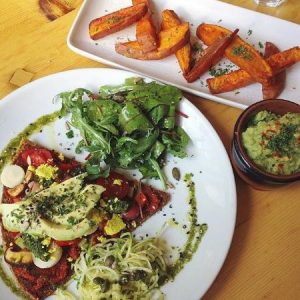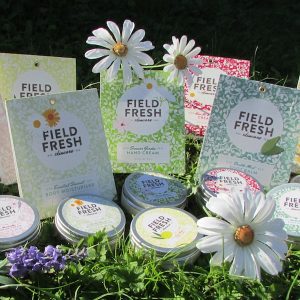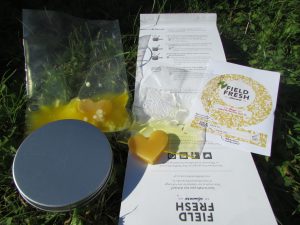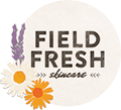
Food trends and Skin food
The lines between what we eat and the products we use to look after our skin are definitely blurring.
The concept of nourishing your skin from the inside by eating the right foods is much in vogue. And the counter can be true too, that using the right skincare products can enhance your internal health.
So there’s a real symbiosis between food and skincare. This means both are important for maintaining good health. And what happens in one area can inform what happens in the other too.
Talking about food

When I first became interested in natural skincare (over 10 years ago now), I was working in marketing and insights. My work gave me lots of opportunities to talk to people about their food preferences, what they chose to eat when out-and-about, and why. It was fascinating to map out the different responses from different types of people.
At that time, organic was big news in the food sector but my focus groups brought out a deal of uncertainty about the benefits of organic, and especially the value of paying extra for organic food. It simply wasn’t clear enough to people, which led to distrust.
The concepts which did resonate with food consumers were ‘local’ and ‘fresh’ – ideas that go hand-in-hand. The benefits of eating what was grown locally and of freshly prepared food was seemingly clear to all without needing much explanation. It felt right.
Following the 2008 financial crisis these views seemed to become even more entrenched.
They’ve since been enhanced by a desire to connect with the natural environment, support our local economies and enjoy food as part of a whole healthy-living experience – whether out-and-about or at home.
Making it easy
I was also observing another trend in the supermarkets. The 1990’s had seen the finessing of the microwave convenience meal. The piercing of film was a familiar sound in many a kitchen. But somehow the ready-to-heat meal-in-a-tray always had that sense of functionality about it, it was no match for real home cooking. But no one had time for that anymore.
So, in the early 2000’s much space in the supermarket cool aisles was given over to semi-prepared ready meals. These are the kits that have everything you need ready prepared and, in some cases, semi-cooked. The home chef therefore has a simple task of maybe squeezing the pre-prepared sauce out of the packet and popping it in the oven for half an hour or so. The result is a wonderful home-made feel, without the effort.
These are the ready-meals that now dominate in our experience-rich society. And they’ve been joined by other formats to help us create fresh, authentic food simply and easily in our own kitchens. Handy curry kits like Spice Entice give you easy access to all the fiddly ingredients you need to get the good aromas going in a homemade curry. Subscription services like Hello Fresh provide kit-form meals to your door.
The trend is now well established in the food sector for healthy ingredients, curated and pre-prepared. Giving a simple hands-on experience and bringing confidence to made-it-myself food.
In these trends it’s the quality of ingredients, the opportunity for new experiences and the simplicity that dominate. The way they are offered enables food to be produced freshly and create that home-made experience.
Lead and lag effect
I was slightly surprised when I looked at the skincare market to see such a dominance of ‘organic’ and glorious packaging as the seemingly de-facto sign of quality. There are many other ways to create a high quality product which the skincare market is now catching up with.
Beautifully presented and organic products still command a premium, and organic certification is hard-won by brands. It proves that a high percentage of the ingredients in their product are from organically produced supplies – giving that assurance customers are looking for. But it doesn’t address the question of ‘why is organic better?’
As an on-looker I could see that consumers were likely to have just the same questions about organic skincare as they had over organic food. It seemed logical, therefore, that the same progression could be made in skincare as in food. That the benefits of using locally produced ingredients and making products fresh would be just as clear to consumers of skincare as they were to consumers of food.
The need for innovation
But, of course, there weren’t many options for consumers to access locally sourced, freshly made skincare. Not unless they were prepared to blend it themselves.
Large skincare producers just don’t seem to offer ‘local’ and ‘fresh’ as options. There are many reasons for this, which I haven’t space to go into right now, but it certainly leaves a gap in the market for local, thoughtful producers to create simple, helpful products that would enable people to have the local and fresh qualities they appreciate in an easy-to-use form.
Well, that’s what I reckoned anyway. So I got brave and put it to the test.
Fresh and local skincare kits

Just like the pre-prepared meal options which just need the final stages to be done at home to create a nourishing, made-it-myself meal, Field Fresh Skincare kits have all ingredients gathered, weighed and prepared so just the final steps of heating and combining can be done at home. And your own fresh, natural and nourishing skincare is easy to achieve.

How have people reacted to fresh skincare kits?
Well, I admit, when these first launched in 2015 it took people some time to get their head around them. I would make up tester pots of the creams and balms, which people loved. Then I’d show them the kit that would enable them to make their own … And listened to the various responses of ‘couldn’t you make it for me?’ and ‘I haven’t got time to do that’ or ‘I don’t trust myself to get it right’.
So I listened and adjusted. I will make up the pots for you fresh-to-order, no problem.
But I’ve stuck with my beliefs about benefits of kits and the joy of being able to blend it yourself and get hands on with ingredients. Why? It’s not stubbornness, it’s ethos. My approach is about enabling and empowerment. I don’t want to provide items to fuel consumerism, I want to make it possible for people to have the confidence to produce their own freshly prepared skincare. Just like others have made it simple for us to have freshly prepared food at home.
Trends are all about the future
Of course you don’t take a new concept like this to market and adjust norms and behaviours overnight. Any student of marketing will understand the curve from Innovators to Early Adopters to Mass Market. And I did have my 2.5% of Innovators – the people who would see what I was doing and get very excited about being able to blend their own.

And now, a couple of years on, I feel securely into the Early Adopter phase. I reckon now it’s about 3 out of every 4 people that I show the kits to who get excited and want to have a go. Though I know these are self-selecting people who have chosen to take an interest, so we’re definitely not at mass market yet. But the trends are all aligning.
Skincare trends for 2019
I never lose my curiosity in looking forward and anticipating ‘what next?’, so the annual future trend reports are a treat!
For a while terms like #cleanbeauty have been trending, and this continues to build. I’m also seeing much more conversation around #personalisedbeauty – a desire to have skincare matched perfectly to your skin’s needs. While there are technological advances that are enabling this, blend-it-yourself has the potential to meet this need in a more down-to-earth way.
Of course the widespread concern about plastic is morphing into a bigger conversation about waste and consumption, the choices we make. In the world of skincare this is emerging as a sub-zero-waste trend which blend-it-yourself plays to beautifully by producing just the amount we need, using sustainable ingredients, minimising skincare miles and reusing or eliminating packaging.
Do food trends still enable us to look further ahead with skincare?
Back to my original premise – are food trends still a predictor of skincare trends?
Let’s take the recently published Mintel report on food and drink trends for 2019 as a case study. In this they identify 3 global innovation trends:
Evergreen consumption: a circular view of sustainability that spans the entire product lifecycle and requires action from suppliers to consumers.
Through the ages: building on today’s dialogue about wellness and transition into more solutions for healthy ageing.
Elevated convenience: matching the premium expectations of consumers in the on-demand age, convenience food and drink will get an upgrade.
What I see here is that we’ve come full circle. Now, it’s not food and drink trends informing skincare, but the other way round. And this is acknowledged by Jenny Zegler, associate director, Mintel Food and Drink who says ‘Expect to also see food and drink manufacturers look to the beauty and personal care industry for inspiration for healthy ageing product development’.
The worlds of food and skincare merge further.
Enduring messages that resonate
Providing further proof from my in-market experience: You won’t be surprised to know, given what the research predicted, that when I tell people the ingredients in Field Fresh Skincare kits are all selected from plants that grow locally to us and that by blending yourself you get absolutely fresh skincare, they nod roundly in agreement, needing no explanation as to why this is a good thing. It’s natural.

